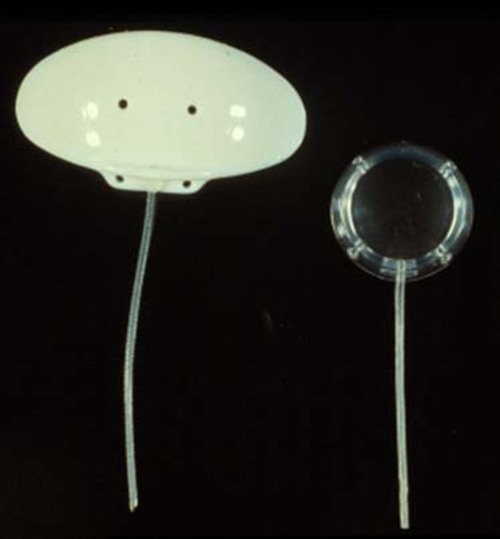Glaucoma Quiz 2

Figure 1
Shows a Baerveldt and Molteno glaucoma shunt implants.
Shows a Baerveldt and Molteno glaucoma shunt implants.

Figure 2
Shows the tube of an Ahmed glaucoma valve implant within the pupil.
Shows the tube of an Ahmed glaucoma valve implant within the pupil.
Answer: Seton is derived FROM the Latin word seta, which means bristle. According to the 25th edition of Stedman's Medical Dictionary ( Williams and Wilkins, 1990) "a whisp of threads, a strip of gauze, a length of wire or other foreign material passed through the subcutaneous tissues or a cyst to form a sinus or a fistula" Setons are used in the treatment of glaucoma to create an alternate drainage pathway for the aqueous fluid.
2. How do modern setons (glaucoma implants) work to treat glaucoma?
Answer: Modern glaucoma implants work by shunting aqueous FROM the anterior chamber through a tube to a distal resevoir. Blood vessels and lymphatics overlying the reservoir then pass the aqueous onto the systemic circulation.
3. What are the indications for seton surgery in glaucoma?
Answer: Generally, seton surgery including using devices such as those developed by Molteno, Baerveldt, Krupin, Schocket, and Ahmed implants are reserved for refractory glaucomas where standard trabeculectomy filtration surgeries are likely to fail or have failed previously. Conditions which may be particularly suitable for seton surgery include glaucoma due to Sturge-Weber, dural-cavernous sinus fistulas, or neovascular glaucoma.
4. What other types of glaucoma surgery may be considered in place of setons?
Answer: Filtration surgery that is augmented by antimetabolities (e.g. mitomycin and/or 5-fluorouracil) may be used as an alternative to seton surgery for the treatment of refractory glaucoma. Cyclodestructive procedures may also be used to control intractable glaucomas, but may lead to phthsis and rarely sympathetic ophthalmia.
5. What are some of the potential complications of seton surgery?
Answer: The main complications of seton surgery include early post-operative hypotony, choroidal effusions, and failure of the implant to adequately lower intraocular pressure. Other potential complications include implant extrusion, wound leaks, tube blockage, and endophthalmitis.